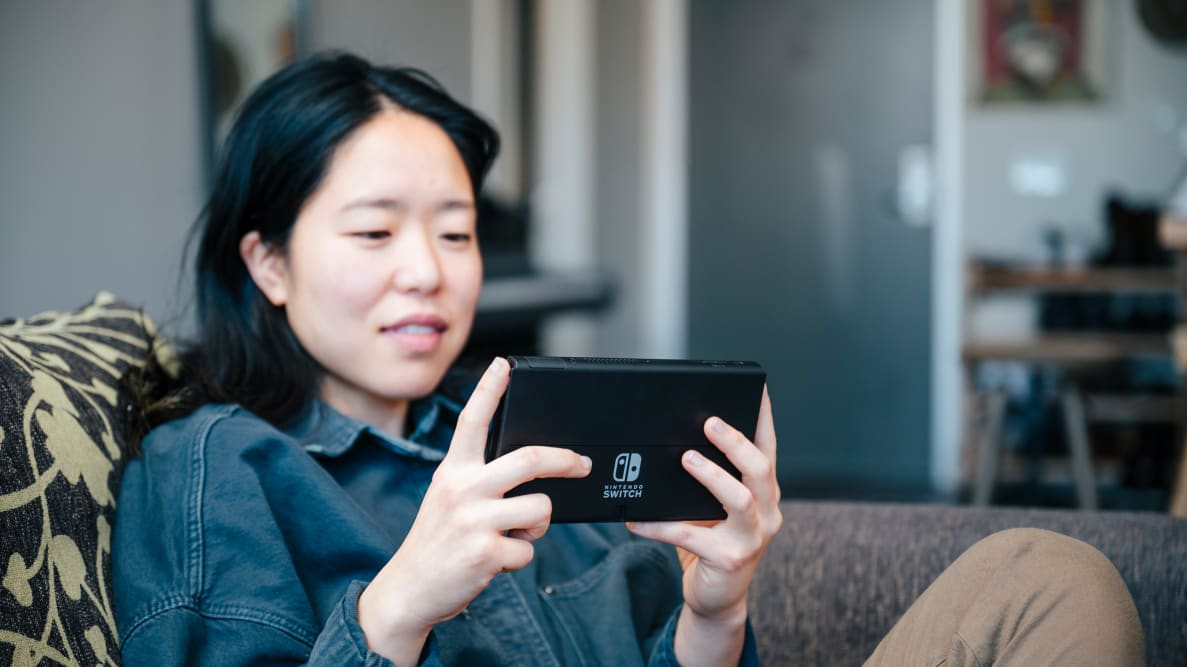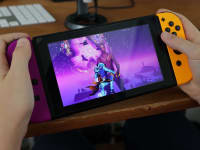Pros
-
Incredible games catalog
-
Playful, ingenious design
-
7-inch handheld screen
Cons
-
Thumbstick drift is common
-
Lacks 4K output
Of course, a lot of people have a Switch they’re already satisfied with. If that’s the case, the new OLED Switch isn’t much of a reason to upgrade. It’s slick, it’s faster, and has better battery life than the original Switch, but it doesn’t play any games the original can’t.
About the Nintendo Switch OLED
The Nintendo Switch OLED earns its namesake from its OLED (Organic Light-Emitting Diode) screen. OLED screens are similar to the LED/LCD screens found on most gadgets and phones (including the original Switch), but their unique design means every pixel provides its own light. That means when it’s off, it’s all the way off, so blacks become truly black giving your picture more contrast.
The new model also inherits some of the benefits that rolled out with the 2019 Nintendo Switch Lite, including a larger battery and more efficient processor. The Switch Lite remains in the lineup as a smaller, cheaper option with controls that are permanently attached.
Nintendo Switch OLED specs
- Price: $349
- Display: 7-inch, 60Hz, 720p OLED panel, touch sensitive
- Processor: 16nm Tegra X1+, 4GB LPDRR4 RAM
- Connectivity: Bluetooth 4.1, Wi-Fi 5
- Controllers: Two detachable Joy-Cons included
- Storage: 64GB internal, MicroSDXC expandable
- Audio: 3.5mm headphone jack, Bluetooth headphones supported
- Dimensions (W x H x D): 9.5 x 4.0 x 0.55 inches
What We Like
The display is big, bright, and beautiful
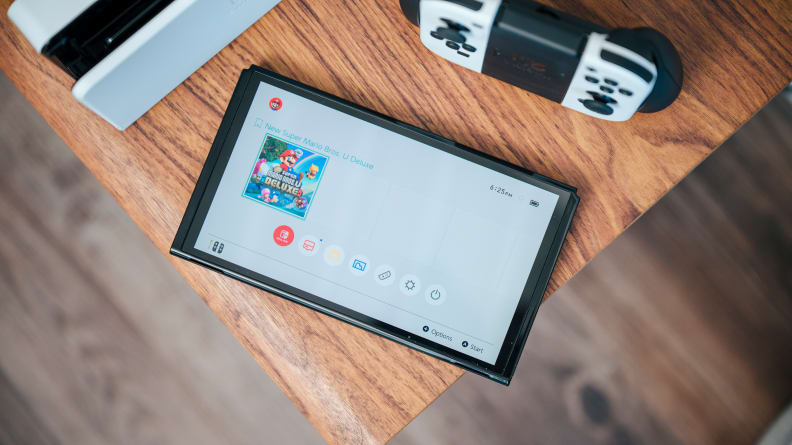
OLED just makes everything look better.
Where else is there to start? The 7-inch OLED screen is the reason for the Switch OLED to even exist, and it is by far the most notable upgrade. It’s still just 720p (so HD instead of Full HD, AKA 1080p), but in handheld mode you’re unlikely to notice much of a difference compared to higher-resolution screens.
One thing you will notice is the OLED’s ability to drive more realistic contrast, punchier colors, and better brightness control. Nintendo’s library of first- and third-party titles tends to lean toward the cartoonish and colorful side, and that style of art really plays to the Switch OLED’s strengths. Similar to the Steam Deck OLED, the move from an LCD panel to an OLED is a night-and-day difference.
The battery life is much longer
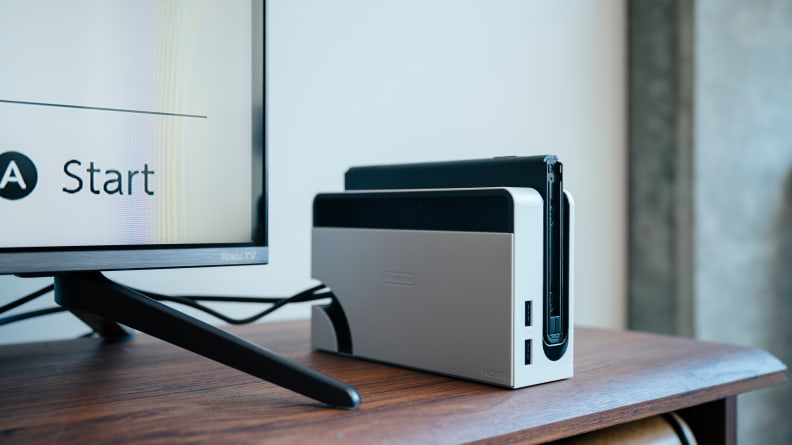
The battery in the Switch OLED and original Switch are the same size, but the OLED delivers up to two hours more battery life.
The main issue with the original Switch? Lackluster battery life. It could be particularly spotty after six months or a year of use, dropping from fix or six hours to around four or less when playing more intensive games like Breath of the Wild or Doom ports.
Though the battery in the Switch OLED seems to be the same 4,200 mAh part as the original, the processor is more efficient. Nintendo lists the approximate battery life as the same (4.5 hours up to 9 hours), but in my experience, you’re more likely to get to the 8-hour mark whereas the 2017 launch model rarely got more than six hours.
The games are still stellar
Yes, we’re reviewing the hardware here, but the only thing that makes the Nintendo Switch a worthwhile purchase is the games. In particular, Nintendo’s first-party exclusive titles like Super Smash Bros. Ultimate, The Legend of Zelda: Tears of the Kingdom, Mario Kart 8, Mario Party, Animal Crossing, Pokémon—the list goes on and on.
The Switch also features a healthy collection of classic games from the Super Nintendo, Nintendo 64, and GameCube eras available through Nintendo’s online service.
What we don’t like
There’s no 4K upgrade in sight
The Nintendo Switch is now seven years old, and rumors have been swirling for more than half that time of a mid-cycle refresh that would take the Switch and ramp up the speed and graphics, offering 4K-ready graphics—at least when docked to your TV, if not in handheld mode.
Unfortunately, that’s not the case. The Switch OLED uses the same processor as the Switch Lite, so the gaming ability is largely the same. It’s dockable, but even when playing in TV mode the processor can only drive gaming up to 1080p (and often with notable upscaling).
It does make sense that Nintendo would hold off on a true upgrade to the Switch since it would fragment its player base between the old Switch and the new, but games today are meant to scale and Nintendo could certainly deliver a 4K-ready Switch without leaving original Switch players behind. Unfortunately it looks like that will have to wait for the Nintendo Switch 2.
The jump to 64GB storage isn’t nearly enough
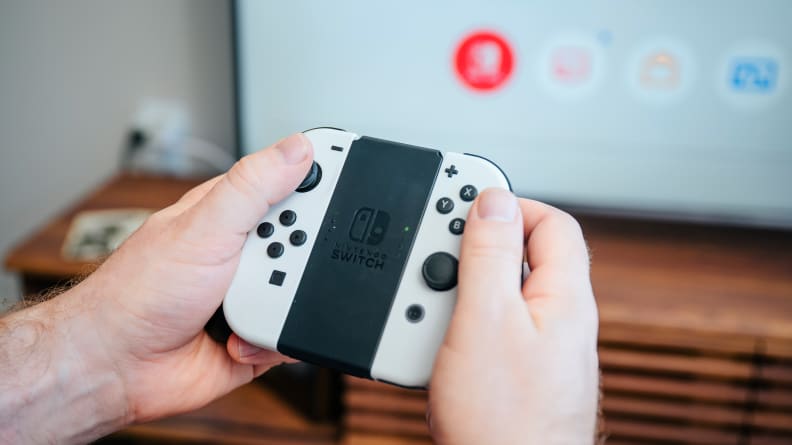
Don't like white Joy-Cons? Nintendo lets you mix and match the colors in different combinations.
This has been a problem across all of tech, but flash storage (the kind you’ll find in just about everything from memory cards to smartphones and gaming consoles) is dirt cheap. There are 512GB SD cards available at retail for under $30. Nintendo bumped the storage from 32GB to 64GB in this revision, but memory prices dropped tremendously in the four years between models.
You can easily add a larger card to the Switch, but you shouldn’t have to. Especially in a console where games are running anywhere from 5-10GB apiece, having internal storage that tops out after just a few games is really unacceptable.
Should you buy the Nintendo Switch OLED?
Yes, if you don’t own a Switch already
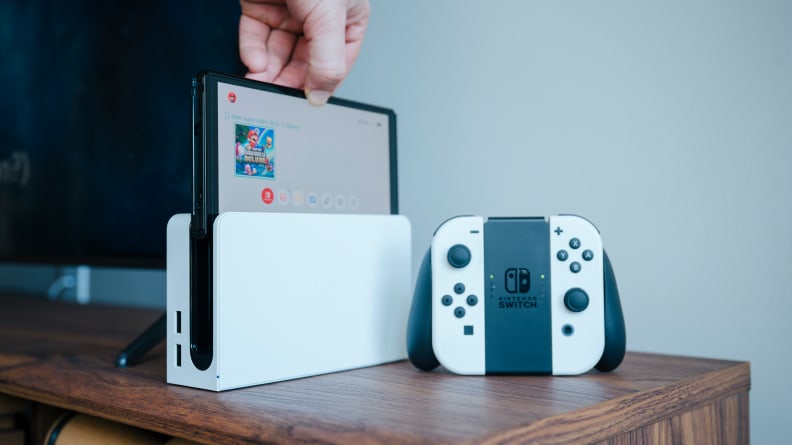
Notable upgrades to the Nintendo Switch OLED version include a 7-inch OLED and longer battery life.
If you already have a Switch, the new OLED model isn’t a good enough value to upgrade. It’s a great console, and the upgrades here are all welcome (if a bit overdue), but it doesn’t fundamentally do anything the original Switch can’t. A number of non-Nintendo handhelds have flooded the market since the OLED’s release and present an equally compelling alternative to upgrading.
But if you don’t own a Switch yet, this is the first one you should look at. Though a used launch model or a Switch Lite will be cheaper, this is the best version of Nintendo’s original Switch vision: a powerful handheld console with great battery life and the ability to transform your gaming experiences from your living room TV to on-the-go seamlessly.
It’s a fantastic entry in Nintendo’s legendary lineup of handheld consoles. It may not be the “Pro” Switch many were hoping for, but it’s easy to see why, in the current market, Nintendo would hold off on that. There’s a ton of life left in this handheld generation for Nintendo, and until someone comes and knocks them off their platform, Nintendo will continue to reign as king of handheld gaming.
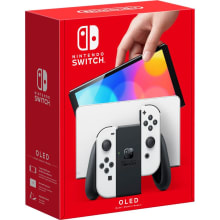
The Nintendo Switch OLED adds a much better screen to the beloved console.
Meet the tester
TJ is the former Director of Content Development at Reviewed. He is a Massachusetts native and has covered electronics, cameras, TVs, smartphones, parenting, and more for Reviewed. He is from the self-styled "Cranberry Capitol of the World," which is, in fact, a real thing.
Checking our work.
Our team is here to help you buy the best stuff and love what you own. Our writers, editors, and experts obsess over the products we cover to make sure you're confident and satisfied. Have a different opinion about something we recommend? Email us and we'll compare notes.
Shoot us an email
